Acura TSX perfect alternative to Accord
By John Gilbert
If you were a loyal Honda Accord buyer, and you knew a new-generation Accord was coming out in September of 2012, would you consider an Accord-like vehicle from Honda that meets or exceeds every feature you always wished the Accord possessed, for about the same money?
If you would you pay $32,000 for the much-anticipated 2013 Accord, would you pay $30,000 to move upscale to the Acura brand for a TSX Special Edition? The current Accord grew too large and hefty, and while the new one might be a little sleeker, a little sportier, with a bit more punch, but with the same good fuel economy, and yet the TSX might be the perfect alternative car.
But, as they say in the car biz, you might not want to wait.
The current 2012 Acura TSX Special Edition is almost a secret, and it definitely is a secret bargain, which combines sporty performance and handling Accord buyers can only dream of, with enough roominess to take care of the Accord’s workaday requirements. And, it might not be around very long, even though its technology and sportiness will never go away.
Honda is usually the best auto manufacturer at keeping secrets, but the summer of 2012 has been filled with spy photos, news leaks and rumors about the new Accord. We’ve been treated to advance reports that the new Accord will be a little smaller than the large current model, which spilled over the boundary from midsize to full-size. We’ve also been teased that the new Accord will have a new generation of engine technology, something to springboard it forward toward the engineering standard we had grown used to expecting from Honda.
Meanwhile, there are all sorts of rumors that Honda’s upscale Acura line, which just added an entry-level ILX to its stable, is planning to phase out the TSX because it’s similar in size and bumps up against both the larger TL and the new ILX. That would leave Acura with the RL luxury line, a TL that could get slightly reduced in size to swallow up the sportier TSX, and the ILX — along with its SUV tandem, the MDX and just-introduced new-generation RDX.
If those rumors are true, the enthusiasts among Acura shoppers will be sorry to see the TSX leave the scene. The Acura line always has had its luxury cars, such as the original Legend, which grew up to become the RL, and it always has had an upscale sporty representative, too. There was the original Integra, which came in sleek 4-door hatchback or 2-door coupe form. I owned one for several years, and it was so thoroughly enjoyable and trouble-free that my older son, Jack, wound up with one too. Years later, he wishes he still had it.
Acura also had the incomparable 2-seat mid-engine sports car, the NSX. Whenever anybody asks me that of all the cars I’ve driven over 40 years of automotive testing, which single car would I most want to own, my answer steadfastly remains: the Acura NSX.
It was from that heritage that Acura also spun off twin models — the RSX 2-door coupe and the TSX, which was a 4-door sedan model, that was pretty much the RSX stretched to house a family, with the same sporty engine, transmission and suspension. As years went by, Honda, remaining separate from Acura, decided to hike the performance level of the Civic Si by giving it the RDX (and TSX) engine, with its dual overhead camshafts instead of the dependable single-cam version of the Civic, and to add firmness and handling to the suspension. It even bolstered the Civic Si with traction control, something the RSX lacked.
In the process, the RSX remained an automotive bargain, but it became difficult to justify charging more for it when the less-expensive and sporty Civic Si, with traction control, was available. So Honda eliminated the RSX, a move that, in a way, might be a predictor for the fate of the future TSX, if rumors hold.
To give the TSX room to grow, Honda added some luxury touches, and a year ago offered an optional V6 along with its high-output 4, separating it a bit from the Civic Si sedan. The 4-cylinder version still seems like all the engine any TSX buyer could want or need, especially when the TSX was able to use the 2.4-liter 4, with its dual-overhead camshafts for higher revving and more horsepower.
For 2012, the Civic Si is offered with a “new” engine, which isn’t new at all except for Civic use. It is the same potent 2.4-liter 4-cylinder that has been a strong and familiar powerplant to Honda and Acura buyers for nearly 20 years — and which currently can be found in the RDX crossover SUV, and the TSX sedan.
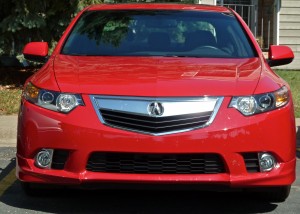
Where its larger siblings, the RL and TL, have undergone curious styling revisions, the TSX is now the most tastefully styled of the brand.
All of which brings us around to a bright red 2012 Acura TSX Special Edition, which, after a week-long road test, has become my favorite vehicle in the entire Acura line. It has none of the heft of the RL — or the current Accord, by the way — and it is unburdened by the over-reaching styling wanderings that took the TL from being the most beautiful car in Honda’s entire universe into some weird, buck-toothed wilderness, complete with chrome-splashed obnoxiousness. The TSX also has more of a sculptured sportiness and some of the luxury leanings of the new ILX.
The Special Edition is more than just the latest TSX. It is, as the name says, special.
The test car shows that Acura designers could, after all, restrain themselves from fastening that big, wide swath of chrome as a beak on all its models. That’s the drawback of a so-called “signature” feature; if it has universal appeal, great, but if it doesn’t, well, the TL’s appeal can disappear, and everybody gets the overdone overbite. The TSX has that widened upper lip on the grille, but it is less intrusive than the other Acuras, presumably because somebody at the home office tackled the radical designer before he could do similar damage.
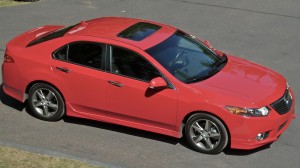
The Special Edition TSX 2.4-liter 4 has 201 horsepower to be guided by a 6-speed manual transmission.
While styling is subjective, I like the subtle contours of the TSX, but its best feature is what’s inside and under the skin.
The 2.4-liter 4-cylinder engine, with 16 valves and dual overhead cams, with i-VTEC variable valve timing control — which set Honda apart from less-high-tech rivals back in 1990 — and with a smooth-as-silk 6-speed manual transmission, brings the TSX fully to life as a sports sedan of the highest order.
We will find out by September of 2012 if all the new Accord rumors are true, but the most prominent one remains the addition of a new engine — a 2.4 with DOHC refined with direct injection, which should help fuel efficiency and performance, and supposedly will deliver 181 horsepower. The new Accord also is supposed to get a CVT, continuously variable transmission.
Yes, direct injection would be great on the 2.4, but until then, the TSX has the same engine without direct injection, but it has been refined to put out 201 horsepower. Hmmm…less refinement and more horsepower?.
The test TSX had a sticker price of $32,310, which includes Special Edition features such as a full underbody sound and aero kit, exclusive Special Edition seats, exclusive Special Edition lighting, with badges to show that it’s the Special Edition, and aluminum pedal plates. The intriguing thing is that after adding up the included upgrades, which total $2,500 if you could buy them, the car instead gets a Special Edition discount of $1,500, which drops the price to $30,810.
A standard delivery charge of $885 afflicts both sticker prices, and while it zips the total price over $33,000, it pushes the Special Edition price only up to $31,695 — still less than the standard TSX without the upgrades. That, is a bargain.
Hyundai has generated a revolution of sorts by adding such details as direct injection to the dual overhead cams of its 2.4-liter 4-cylinder, reaching 200 horsepower. The new Accord coming out supposedly will have 181 horsepower. The TSX Special Edition’s 2.4 hits 201 horsepower, and that’s without direct injection.
The TSX handles with firm efficiency, too, and from the driver’s seat, everything falls into place. That includes the shift lever, which zips through the six gears with optimal smoothness, adding fun and sportiness to the 30-miles-per-gallon efficiency. As automatic and dual-clutch transmissions become more and more sophisticated, there are fewer and fewer stick shift models available. The TSX proves there is still a place for them, for those companies, and consumers, who still prefer the basic manual shifting. Especially this sort of manual shifting.
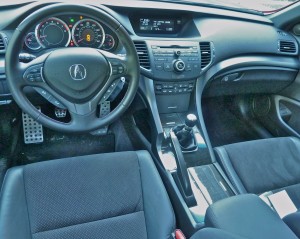
Controls are sporty and ergonomically sound, with non-glare black from its soft-toiuch dash down to the console.
I’m not sure all the buttons and controls on the center stack are necessary, and my iPhone was difficult to code into the hands-free system, but the center stack and console are refreshingly simple, even austere, because everything is a matte black, from the soft-touch texture of the dashboard to the button-filled center stack and on down to the console. Speedometer, tachometer and other instruments are simple and straightforward, and nowhere is there the bright, glare-catching accents of glossy silver trim that are so common on new cars, where a dash of flash seems more prominent than glare-free ergonomics..
In short, it’s the type of interior command post that gave Honda the reputation it richly deserved for ergonomic excellence. The same sort of ergonomic excellence BMW used to be able to boast about before iDrive, and now only seems to appear in base models.
My wife, Joan, who has become an expert at the benefits of coordinated energy for physical work with humans, was greatly taken by the TSX’s attributes. “I like the aero quality of the design, which makes the overall look pleasing,” said Joan. “The inner design is subtle and classy, and not flashy. The design inside and out made the car feel comfortable to look at, and it has all the energy of the old Hondas.”
I never thought of those particular attributes, but I couldn’t agree more. Maybe the new Accord, with its newly redone 2.4, will be as sporty, and it will offer a 6-speed stick shift along with its CVT automatic. But the Acura TSX is here, now, and it offers all of the attributes that established Honda as a high-tech leader and benchmark of inexpensive sporty sedans. If it is going to go away, the TSX Special Edition might be one to capture and hang on to.
Comments
Tell me what you're thinking...
and oh, if you want a pic to show with your comment, go get a gravatar!


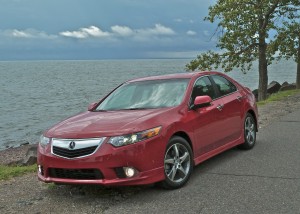
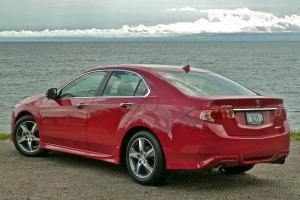
 John Gilbert is a lifetime Minnesotan and career journalist, specializing in cars and sports during and since spending 30 years at the Minneapolis Tribune, now the Star Tribune. More recently, he has continued translating the high-tech world of autos and sharing his passionate insights as a freelance writer/photographer/broadcaster. A member of the prestigious North American Car and Truck of the Year jury since 1993. John can be heard Monday-Friday from 9-11am on 610 KDAL(www.kdal610.com) on the "John Gilbert Show," and writes a column in the Duluth Reader.
John Gilbert is a lifetime Minnesotan and career journalist, specializing in cars and sports during and since spending 30 years at the Minneapolis Tribune, now the Star Tribune. More recently, he has continued translating the high-tech world of autos and sharing his passionate insights as a freelance writer/photographer/broadcaster. A member of the prestigious North American Car and Truck of the Year jury since 1993. John can be heard Monday-Friday from 9-11am on 610 KDAL(www.kdal610.com) on the "John Gilbert Show," and writes a column in the Duluth Reader.